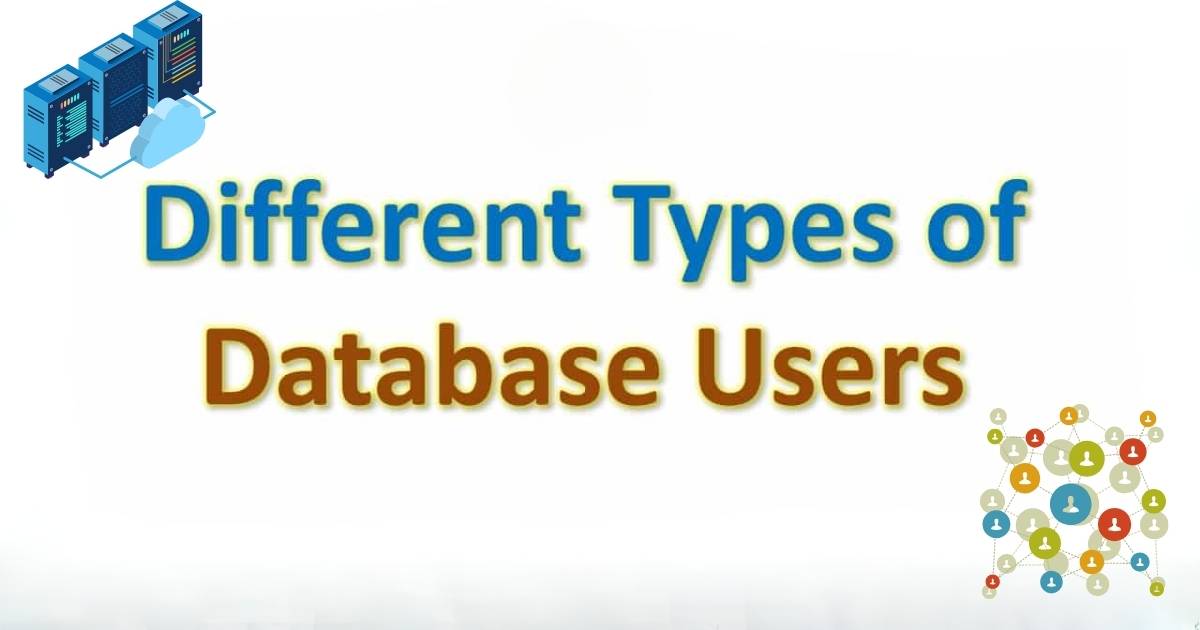In today’s data-driven world, databases have become the backbone of virtually every organization, storing and managing critical information that drives decision-making, operations, and growth.
Managing and utilizing these powerful data repositories effectively requires a deep understanding of the various roles and responsibilities involved.
Enter: database users – the diverse group of individuals who interact with, access, and benefit from databases in myriad ways.
A database is a structured collection of logically related data, designed to meet the specific needs of an organization or system.
From financial records to customer information, inventory data to scientific research findings, databases serve as the central repository for invaluable information.
But what makes these data repositories truly powerful is the ability to effectively manage, manipulate, and extract insights from the stored data – a task that falls squarely on the shoulders of database users.
To ensure smooth operations, data integrity, and optimal performance, it’s crucial to understand the different types of database users and their distinct roles. Let’s dive in and unravel this intricate ecosystem.
What are Database Users?
In its simplest form, a database user is any individual or entity that accesses, interacts with, or benefits from a database.
This diverse group encompasses a wide range of roles, from administrators who oversee the entire system to end-users who leverage the data for specific tasks.
Each type of user has unique responsibilities, privileges, and levels of access, contributing to the overall management and utilization of the database.
Types of Database Users
The world of database users is a vibrant tapestry, with each role playing a vital part in ensuring the seamless functioning and effective utilization of these powerful data repositories.
Let’s explore the various categories in detail:
Database Administrator (DBA)

Think of the Database Administrator (DBA) as the gatekeeper and supreme authority of the database realm.
This individual (or team) is the “superuser” responsible for virtually every aspect of database management, from ensuring data integrity and security to optimizing performance and managing user access.
DBAs wield immense power and privileges, as they have complete control over the data stored in the database, as well as the application programs that interact with it.
They are the ones who grant or revoke privileges for other users, ensuring that only authorized individuals can access sensitive information.
A castle with a vast treasure trove of valuable data – the DBA is the ruler who oversees and safeguards this precious resource, making critical decisions about its protection, maintenance, and distribution.
Database Designers
While DBAs are the guardians of the database, database designers are the architects who shape its very structure.
These specialized users are responsible for creating the conceptual and logical designs that form the foundation of a database.
Database designers work closely with DBAs, application developers, and other stakeholders to ensure that the database is optimized for its intended use case.
They employ advanced data modeling techniques, such as entity-relationship diagrams (ERDs), to define the data requirements and determine the optimal data structures.
Think of a database designer as the brilliant engineer who carefully plans and constructs a robust, flexible, and scalable framework – one that can withstand the ever-evolving demands of the organization while maintaining efficiency and performance.
System Analyst
In the dynamic world of databases, system analysts play a crucial role in analyzing and improving the systems and processes involved in database management.
These experts work hand-in-hand with DBAs, developers, and end-users to understand their requirements and identify areas for optimization.
System analysts keep a keen eye on the latest database technologies and trends, recommending new solutions that could enhance performance, efficiency, or functionality.
They also act as troubleshooters, resolving issues such as performance bottlenecks, data integrity concerns, or compatibility challenges.
Think of system analysts as the diagnostic experts who continuously monitor the “health” of the database ecosystem, proactively identifying potential problems and providing tailored solutions to keep everything running smoothly.
Application Developer
Application developers are the bridge between the database and the end-users, creating the software interfaces that enable seamless interaction with the data.
These skilled programmers develop applications using languages like Java, Python, or C++, and interact with the database through DML (Data Manipulation Language) queries.
Application developers need a deep understanding of database design principles, SQL (Structured Query Language), and the specific database management system being used.
They collaborate closely with DBAs and designers to ensure that the application requirements are properly translated into the database structure and functionality.
Imagine a user-friendly mobile app that allows you to easily access and manage your financial data – that sleek and intuitive interface is the handiwork of an application developer, seamlessly connecting the end-user to the powerful database behind the scenes.
Naïve Users / Parametric Users
Not all database users are tech-savvy experts – some are simply everyday individuals who interact with databases through user-friendly applications.
These naïve users, also known as parametric users, are unsophisticated end-users who have little to no knowledge of the underlying database system.
Imagine a scenario where you book a flight online or use a banking app to transfer funds. In these cases, you are a naïve user, interacting with a database through a carefully designed, menu-driven application interface.
You don’t need to understand the complexities of the database – you simply input your parameters (travel dates, account information, etc.), and the application translates your actions into database queries and operations.
The key for naïve users is a seamless, intuitive experience that abstracts away the technical complexities, allowing them to benefit from the power of databases without needing specialized knowledge.
Sophisticated Users
On the opposite end of the spectrum from naïve users are sophisticated users – the database power users who wield advanced skills and knowledge.
These individuals, often engineers, scientists, or business analysts, have a deep understanding of database design principles, data modeling, and SQL.
Sophisticated users are comfortable writing complex queries and scripts to extract, manipulate, and analyze data from the database.
They leverage their expertise to support critical business decisions, scientific research, or data-driven initiatives that require intricate data analysis and manipulation.
Imagine a team of data scientists working on cutting-edge machine learning models to predict customer behavior.
These sophisticated users would likely write SQL scripts to extract and transform vast amounts of data from various databases, enabling them to train their algorithms and uncover valuable insights.
End-user
End-users are the individuals who directly interact with the database, either through applications or the database management system itself.
They may have varying levels of privileges, such as read-only access or the ability to update specific fields or tables.
End-users can be found in virtually every department or function within an organization, from sales teams accessing customer data to finance professionals managing financial records.
Their level of access and permissions is carefully controlled by the DBA based on their specific roles and responsibilities.
Picture a sales representative who needs to quickly retrieve customer information or update contact details – they are an end-user leveraging the database to perform their daily tasks efficiently and effectively.
Guest user

In certain scenarios, organizations may need to grant limited, read-only access to external entities or individuals.
These guest users are typically granted access to specific subsets of data within the database, often for purposes such as audits, collaborations, or compliance requirements.
For example, a consulting firm may be granted guest user access to review a company’s financial data as part of an audit process.
Or, a research institution may provide guest user access to a subset of their database to enable collaboration with external partners.
Ensuring proper access control and data security is paramount when dealing with guest users, as they represent potential entry points for unauthorized access or data breaches.
Casual Users / Temporary Users
Some database users may only require access for a short period, such as consultants, contractors, or temporary employees.
These casual users or temporary users interact with the database for a specific task or project, and their access is typically revoked or suspended once their engagement is complete.
Imagine a scenario where a software development company brings in a team of contractors to work on a specific project.
These temporary users would be granted access to the relevant databases and resources for the duration of the project, but their privileges would be carefully managed and audited to ensure data security and integrity.
Proper access management and auditing are crucial when dealing with casual or temporary users, as their presence within the database ecosystem is transient and may pose potential security risks if not properly controlled.
FAQ’s
While exploring the intricate world of database users, a few common questions often arise. Let’s address them:
What is the meaning of database?
A database is a structured collection of logically related data, designed to meet the specific needs of an organization or system.
It serves as a central repository for storing, organizing, and managing information in a way that enables efficient retrieval, manipulation, and analysis.
Think of a database as a meticulously organized digital library, where vast amounts of information are carefully cataloged, cross-referenced, and made easily accessible to those who need it.
What do you mean by DBMS?
DBMS, or Database Management System, is a collection of software programs that enable the creation, management, and administration of databases.
It serves as the intermediary between the database and its users, providing tools and interfaces for data storage, retrieval, security, backup, and overall maintenance.
Popular examples of DBMS software include Oracle, MySQL, Microsoft SQL Server, and PostgreSQL.
These powerful systems act as the backbone for managing and interacting with databases, ensuring data integrity, performance optimization, and user access control.
Explain some advantages of DBMS?
Implementing a Database Management System offers numerous advantages, including:
- Data Abstraction and Organization: DBMS organizes data in a logical and structured manner, abstracting away the complexities of physical storage and enabling efficient data management.
- Minimized Redundancy and Inconsistency: By centralizing data in a single repository, DBMS reduces the risk of redundant or inconsistent data, improving data integrity and reliability.
- Ease of Data Manipulation: DBMS provides tools and interfaces for seamlessly inserting, updating, and deleting data, streamlining data management processes.
- Multi-user Access and Data Sharing: Multiple users can access and share data concurrently through a DBMS, enabling collaboration and efficient information sharing within organizations.
- Data Security and Access Control: DBMS implements robust security mechanisms, such as user authentication, access controls, and data encryption, to protect sensitive information from unauthorized access or breaches.
- Improved Data Integrity and Consistency: Through features like transaction management, referential integrity, and data validation rules, DBMS ensures data remains accurate, consistent, and reliable across the entire system.
- Backup and Recovery: DBMS offers mechanisms for creating regular backups and enabling data recovery in the event of system failures or data loss, safeguarding valuable information.
Explain some disadvantages of DBMS?
While Database Management Systems offer numerous benefits, they also come with potential drawbacks or limitations:
- High Costs: Implementing a robust DBMS can be expensive, requiring significant investments in hardware, software licenses, and specialized personnel for installation, maintenance, and support.
- Complexity and Training Requirements: DBMS systems can be complex, requiring extensive training and expertise to configure, optimize, and manage effectively. This can increase costs and create a steep learning curve for organizations.
- Migration Challenges: Migrating from legacy file-based systems or older database systems to a new DBMS can be a time-consuming and challenging process, often requiring data conversion, application rewrites, and extensive testing.
- Performance Issues: As databases grow in size and complexity, performance can become a challenge, requiring careful tuning, indexing strategies, and hardware upgrades to maintain optimal performance.
- Data Loss or Corruption Risks: Despite robust security and backup mechanisms, there is always a risk of data loss or corruption due to hardware failures, human errors, or malicious attacks, which can have severe consequences for organizations.
- Vendor Lock-in: Some DBMS solutions are proprietary, which can lead to vendor lock-in, making it difficult and costly to migrate to alternative solutions in the future.
- Scalability Limitations: Certain DBMS solutions may struggle to scale efficiently as data volumes and user loads increase, potentially requiring costly upgrades or migrations to more scalable solutions.
While these disadvantages should be carefully considered, the benefits of implementing a robust DBMS often outweigh the potential drawbacks, especially for organizations that rely heavily on data-driven operations and decision-making.
Final Thoughts
In conclusion, understanding the diverse roles and responsibilities of database users is essential for effective database management and utilization.
From the all-powerful DBA to the end-users leveraging data for specific tasks, each type of user plays a vital part in ensuring the smooth functioning and optimal performance of these powerful data repositories.
By recognizing the unique contributions of database administrators, designers, analysts, developers, and various user categories, organizations can establish clear roles, responsibilities, and access controls, fostering a collaborative and secure database ecosystem that drives informed decision-making and operational excellence.
As data continues to be the lifeblood of modern organizations, mastering the intricate world of database users will be a key competitive advantage, enabling organizations to unlock the full potential of their data assets and thrive in an increasingly data-driven landscape.











